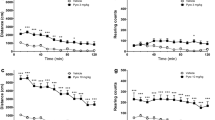Abstract
Three major metabolites (M1, M2, M3) of nomifensine (8-amino-1,2,3,4-tetrahydro-2-methyl-4-phenyl-isoquinoline) are formed by hydroxylation and methoxylation of the phenyl ring. They were compared with nomifensine
-
1.
in various psychopharmacological tests in vivo, carried out in mice after oral or i.p. treatment and
-
2.
in neurochemical in vitro studies, measuring inhibition of noradrenaline (NA), dopamine (DA), and serotonin (5-HT) uptake in rat brain synaptosomes.
M1 (4′-hydroxy-nomifensine) was the most active metabolite, while M2 and M3 had little or no effect in pharmacological tests. M1 reversed reserpine hypothermia in doses >2.5 mg/kg, antagonized tetrabenazine catalepsy (ED50 68 mg/kg) and reversed oxotremorine hypothermia (ED50 33 mg/kg). In these tests nomifensine was also active, being about 3–10 times more potent than M1. In contrast to nomifensine M1 had also serotoninergic activity, potentiating both phenelzine-induced twitching (ED50 11 mg/kg) and the anticonvulsant effect of 5-hydroxytryptophan. Moreover, M1 prolonged the hexobarbital sleeping time in doses >10 mg/kg, prevented nicotine-induced convulsions (ED50 58 mg/kg) and reduced the oxotremorine tremor (ED50 59 mg/kg). The LD50 of M1 was 1100 mg/kg orally.
In vitro M1 was equipotent with nomifensine in inhibiting DA uptake (IC50 1.5×10-7 M) and twice as active in inhibiting NA uptake (IC50 1.1×10-8 M). In contrast to nomifensine M1 was also a potent inhibitor of 5-HT uptake (IC50 3.3×10-7 M). M2 and M3 were less active than M1 in all experiments.
The results suggest that M1 may have antidepressant effects in man and may contribute to the clinical effects of nomifensine.
Similar content being viewed by others
References
Buus Lassen, J., Squires, R. F., Christensen, J. A., Molander, L.: Neurochemical and pharmacological studies on a new 5-HT-uptake inhibitior, FG 4963, with potential antidepressant properties. Psychopharmacologia (Berl.) 42, 21–26 (1975)
Costall, B., Kelly, D. M., Naylor, R. J.: Nomifensine, a potent dopaminergic agonist of antiparkinson potential. Psychopharmacologia (Berl.) 41, 153–164 (1975)
Gerhards, H. J., Carenzi, A., Costa, E.: Effect of nomifensine on motor activity, dopamine turnover rate and cyclic 3′,5′-adenosine monophosphate concentrations of rat striatum. Naunyn-Schmiedeberg's Arch. Pharmacol. 286, 49–63 (1974)
Hendley, E. D., Snyder, S. H., Fauley, J. J., Lapidus, J. B.: Stereoselectivity of catecholamine uptake by brain synaptosomes: studies with ephedrine, methylphenidate and phenyl-2-piperidylcarbinol. J. Pharmacol. exp. Ther. 183, 103–116 (1972)
Heptner, W., Hornke, I., Cavagna, F., Fehlhaber, H. W., Rupp, W., Neubauer, H. P.: Metabolism of nomifensine in man and animal species. Drug Res. (in press 1976)
Hoffmann, I., Erhart, G., Schmitt, K.: 8-Amino-4-phenyl-1,2,3,4-noline, a new antidepressant Drug Res. 23, 45–50 (1973)
Hoffmann, I., Erhart, G., Schmitt, K.: 8-amino-4-phenyl-1,2,3,4-tetrahydroisochinoline, eine neue Gruppe antidepressiver Psychopharmaka. Drug Res. 21, 1045 (1971)
Horn, A. S., Coyle, J. T., Snyder, S. H.: Catecholamine uptake by synaptosomes from rat brain: structure-activity relationships of drugs with differential effects on dopamine and norepinephrine neurons. Molec. Pharmacol. 7, 66–80 (1971)
Hunt, P., Kannengiesser, M.-H., Raynaud, J.-P.: Nomifensine: a new potent inhibitor of dopamine uptake into synaptosomes from rat brain corpus striatum. J. Pharm. Pharmacol. 26, 370–371 (1974)
Kuczenski, R.: Effects of catecholamine releasing agents on synaptosomal dopamine biosynthesis: multiple pools of dopamine or multiple forms of tyrosine hydroxylase? Neuropharmacology 14, 1–10 (1975)
Schacht, U., Heptner, W.: Effect of nomifensine (Hoe 984), a new antidepressant, on uptake of noradrenaline and serotonin and on release of noradrenaline in rat brain synaptosomes. Biochem. Pharmacol. 23, 3413–3422 (1974)
Snyder, S. H., Coyle, J. T.: Regional differences in 3H-norepinephrine and 3H-dopamine uptake into rat brain homogenates. J. Pharmacol. exp. Ther. 165, 78–86 (1969)
Sulser, F., Watts, J., Brodie, B. B.: On the mechanism of antidepressant action of imipramine like drugs. Ann. N.Y. Acad. Sci. 96, 279–286 (1962)
Whittaker, V. P.: The synaptosome. In: Handbook of neurochemistry, Vol. II A. Lajtha, ed., pp. 327–364. New York-London: Plenum Press 1969
Woodbury, L. A., Davenport, V. D.: Deseign and use of a new electroshock seizure apparatus and analysis of factors altering seizure threshold and pattern. Arch. int. Pharmacodyn. 92, 97–107 (1952)
Author information
Authors and Affiliations
Rights and permissions
About this article
Cite this article
Kruse, H., Hoffmann, I., Gerhards, H.J. et al. Pharmacological and biochemical studies with three metabolites of nomifensine. Psychopharmacology 51, 117–123 (1977). https://doi.org/10.1007/BF00431726
Received:
Issue Date:
DOI: https://doi.org/10.1007/BF00431726




